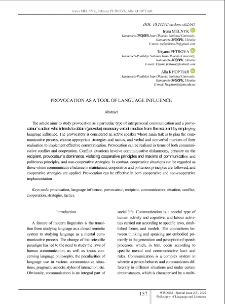Object
Title: Provocation as a Tool of Language Influence
Journal or Publication Title:
Date of publication:
Volume:
Number:
ISSN:
Corporate Creators:
Խ․ Աբովյանի անվան հայկական պետական մանկավարժական համալսարան
Coverage:
Abstract:
The article aims to study provocation as a particular type of interpersonal communication and a provo-cateur‟s action who intends to obtain (provoke) necessary verbal reaction from the recipient by employing language influence. The provocateur is considered an active speaker whose main task is to plan the com-municative process, choose appropriate strategies and tactics, and verbal and nonverbal markers of their realisation to implement effective communication. Provocation can be realised in terms of both communi-cative conflict and cooperation. Conflict situations involve communicative disharmony, pressure on the recipient, provocateur‟s dominance, violating cooperative principles and maxims of communication and politeness principles, and non-cooperative strategies. In contrast, cooperative situations can be regarded as those where communicative balance is maintained, cooperative and politeness principles are followed, and cooperative strategies are applied. Provocation can be effective in both cooperative and non-cooperative implementation
Place of publishing:
Երևան
Publisher:
Format:
Identifier:
oai:arar.sci.am:372092
Language:
Object collections:
Last modified:
Oct 8, 2025
In our library since:
Apr 1, 2024
Number of object content hits:
37
All available object's versions:
https://arar.sci.am/publication/401959
Show description in RDF format:
Show description in OAI-PMH format:
-
Իմաստություն=Wisdom=Мудрость
-
Իմաստություն, 2013, N 1
-
Իմաստություն, 2014, N 1 (2)
-
Իմաստություն, 2014, N 2 (3)
-
Իմաստություն, 2015, N 1 (4)
-
Wisdom, 2015, N 2 (5)
-
Wisdom, 2016, N 1 (6)
-
Wisdom, 2016, N 2 (7)
-
Wisdom, 2017, N 1 (8)
-
Wisdom, 2017, N 2 (9)
-
Wisdom, 2018, N 1 (10)
-
Wisdom, 2018, N 2 (11)
-
Wisdom, 2019, N 1 (12)
-
Wisdom, 2019, N 2 (13)
-
Wisdom, 2020, N 1 (14)
-
Wisdom, 2020, N 2 (15)
-
Wisdom, 2020, N 3 (16)
-
Wisdom, 2021, N 1 (17)
-
Wisdom, 2021, N 1 (1) Special issue
-
Wisdom, 2021, N 2 (18)
-
Wisdom, 2021, N 3 (19)
-
Wisdom, 2021, N 4 (20)
-
Wisdom, 2022, N 1 (21)
-
Wisdom, 2022, N 1 (2) Special issue
-
Wisdom, 2022, N 2 (22)
-
Wisdom, 2022, N 2 (3) Special issue
- Editorial board
- Contents
- Editor`s Foreword
- New Nakhichevan Dialect as an Element of the Armenian National Identity
- Philosophy of Dramatisation in the Context of Art Interaction in W. S. Maugham’s Novels
- Modern Ukrainian Grand Narrative: Prospects for Evolution
- Hate Language Produced by Indonesian Figures in Social Media: From Philosophical Perspectives
- Existential-Ontological Manifestations of Time in Khrimian Hayrik’s Essay “Time and Its Essence”
- Philosophical and Discursive Approaches to the Categorisation of Modal Meanings in Multimodal Texts
- The Novels by T. Hardy “Tess of the D’urbervilles” and “Loose” by Panas Myrnyi: Peculiarities of Stylistic Narration
- Problems of Studying the Verbal Semantics of Differential Languages in the Conditions of Bilingualism
- Philosophical Conception of Stable Verse Forms (Based on Yeghishe Charents’s Poetry Analysis)
- Synergetic Concepts “Chaos” and “Order” in Modern English Verbo-Creating Processes
- Paradigm of the Competence of Linguists in the Education System in the Context of Understanding the Philosophy of Language
- Nikolay Gogol and Raphael Patkanyan: The Philosophy of Horror
- Speech Aggression in Corporate Communication: The Gender Aspect in the Philosophy of Culture
- Camus’ Understanding of the Paradoxically Multidimensional Human Being
- US Presidents’ Political Speeches as a Means of Manipulation in 21st Century Society
- Provocation as a Tool of Language Influence
- Promise: Semantic, Communicative and Temporal Aspects
- Various Language-Philosophy Approaches to the Categorization of the Professional Oil Language in English and Russian
- The Role of Personality Type and Self-Determination of Students Majoring in Non-Philological Specialities While Building English for Professional Purposes Competence
- English Biblicisms in Colloquial Speech and a Literary Text: Looking for the Right Interpretation
- Philosophical and Ethical Problems of the Category “Life” in Michael Kozoris’s Novella “Chornohora Speaks”
- The Folk Medicine Concept in Vernacular English of the XIX Century
- Language-Philosophy Anomalies in the Framework of Free Indirect Speech: By the Example of Marina Tsvetaeva’s Prose
- Exploring the Origin of the Present-Day Human Self on the Fringes of Linguistic Advancement
- Perception of José Ortega y Gasset’s Works in Essays of Oksana Zabuzhko
- English Occult Discourse as a Cultural Phenomenon
-
Wisdom, 2022, N 3 (23)
-
Wisdom, 2022, N 3 (4) Special issue
-
Wisdom, 2022, N 4 (24)
-
Wisdom, 2023, N 1 (25)
-
Wisdom, 2023, N 2 (26)
-
Wisdom, 2023, N 3 (27)
-
Wisdom, 2023, N 4 (28)
-
Wisdom, 2024, N 1 (29)
-
Wisdom, 2024, N 2 (30)
-
Իմաստություն, 2013, N 1
| Edition name | Date |
|---|---|
| Melnyk, Iryna, Provocation as a Tool of Language Influence | Oct 8, 2025 |





